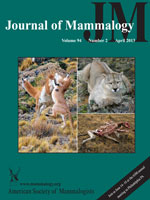The Patagonian weasel (Lyncodon patagonicus) is one of the least known carnivores from South America, and excluding some contributions, knowledge of it seems anecdotal. It is supposed to inhabit herbaceous and arid environments of Argentina and Chile. Here we assess the potential distribution of the Patagonian weasel both during the present and the Last Glacial Maximum (LGM). We also integrate some of this information, providing a historical and geographic analysis (both through ecological niche modeling and biogeographic schemes) of the distribution of L. patagonicus. We found 2 major core areas of distribution, 1 in northwestern Argentina and another in southern Argentina (i.e., Patagonia). Patagonian weasel distribution seems to be primarily related to cold areas with marked temperature seasonality and elevations below 2,000 m above sea level. From LGM to the present, we observed a major retraction in potential distribution areas that might indicate the existence of a vicariance process affecting Patagonian weasel distribution.
El Huroncito Patagónico (Lyncodon patagonicus) es uno de los carnívoros menos conocidos de Sudamérica, y excluyendo algunas contribuciones, su conocimiento parece anecdótico. Se supone que habita ambientes áridos con vegetación herbácea de Argentina y Chile. En el presente estudio evaluamos la distribución potencial del Huroncito Patagónico durante el presente y el Último Máximo Glacial (UMG). Para ello integramos información proveniente de análisis históricos y geográficos (Modelado de Nicho Ecológico y esquemas biogeográficos) de la distribución de L. patagonicus. De esta manera obtuvimos dos grandes áreas núcleo de distribución para la especie, una en el noroeste de Argentina y otra hacia el sur de Argentina (i.e., Patagonia). La distribución del Huroncito Patagónico parece estar relacionada en primer lugar con áreas frías de marcada estacionalidad térmica y altitudes por debajo de los 2000 m.s.n.m. El modelo generado indica que desde el UMG hasta el presente, hubo una mayor retracción en las áreas de distribución potencial, lo cual podría indicar la existencia de un proceso de vicarianza que afectó la distribución del Huroncito Patagónico.





